The Yellow Nose of Texas
The “Yellow Nose of Texas”
There's a yellow ‘plane in Texas
That I'm a goin’ down to see
No other pilot knows her
No pilot, only me
You may talk about your Ayers Thrush
And sing of your Paw-nee
But the Yellow Nose of Texas
Is the only plane for me.
Mid Valley Flying Service makes a last trim pass over a cotton field’s border. Using wind to drift the dust into the field’s tight corner, the pilot shows the farmer, driving an old and dented ’41 Chevy pick-up, that he’s “gettin’ the corners.” This event takes place somewhere off Highway 90 in East Texas around the early fifties.
The scene depicts an aerial applicator finishing the days work. DDT, the powdered insecticide of that day, is what gave rise to the commonly applied moniker, “crop duster”. The scene captures the tight quarters pilots in this hazardous profession work in and around as the pilot pulls up, closes the gate, shutting off the dust, and applies power along with heavy control input to avoid the obstacles.
“Never go over when you can go under” runs the saying. You can see the wires against the sky when you’re comin’ in underneath them, but they tend to disappear when you are looking down at ‘em. As the pilot pulls up steeply to avoid various obstructions like power lines, telephone poles, billboards and barns, the “flagger”, marking the rows for the pilot by stepping them off, gives him a hearty wave-off with his flag.
The aircraft, a surplus, war-weary Army Air Corps PT-17, traditionally known by its designer’s name, “Stearman”, has been converted to aerial application operations with a 450 hp, Pratt & Whitney 985 replacing the Air Corp’s contract, 220 hp Continental R-670, upgrading aircraft performance by doubling the available horsepower. The Continental’s fixed pitch propeller has been replaced by a Hamilton standard constant speed propeller, allowing for smoother engine performance due to constant rpm control. The large, bright yellow prop spinner, surplus from a twin Beech C-45, has been installed to protect the Hydromatic’s finely machined pitch mechanism from the corrosive dust and elements.
The “N” number displays the recently outdated system of putting an “R” in the number to indicate the aircraft’s restricted, agricultural status. “Restricted” is also posted below the cockpit. The “R” was dropped from the numbering system in 1948. However, aircraft with the old registration numbers were kept on FAA books until being repainted with a new number. The instructor’s cockpit of the former training plane is now occupied by a chemical hopper, smoothed over with a hatch cover. The “top dresser” is using a “spreader” to disburse the last of his DDT load. The hopper gate feeding the spreader is controlled by the pilot using a leaver in the cockpit aptly termed the “money handle.”
The dilapidated barn located on a deteriorating, yet still operating, farm is indicative of the besieged small American farmer, who yields not only to the increasing commercialization of agribusiness, but the encroaching urban environment as well, indicated here by a freshly graveled road, power and telecommunication wire installation and a streetlamp above the turnoff.
A white horse drinks from the polluted livestock “tank” as the tree, providing shade at water’s edge, is slowly poisoned and dies. The lineman above, strings new wire as a young lady leads her horse back to pasture. Farm hands load hay to take to other pastures while the farm foreman inspects the front tractor tire for wear. A black stallion rears in alarm at the low flying aircraft. The heavy traffic on the road is yet another indication of the progress encroaching on America’s agricultural treasure.
It’s the end of an era, marked by the second great global conflict, and the beginning of a new age of progress whereby wartime bombers will be made into toasters and obsolete training planes are put to work in yeoman harness.
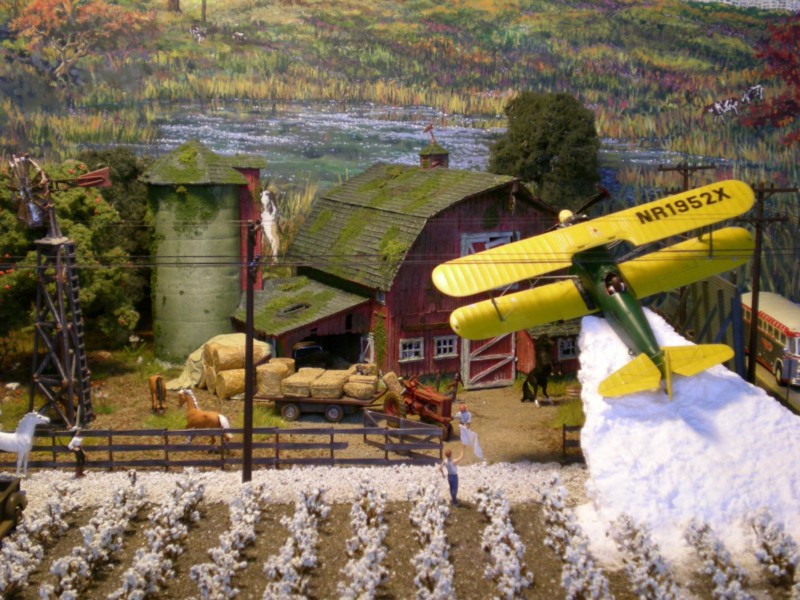
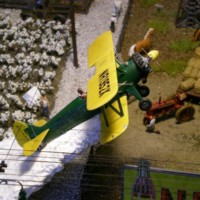
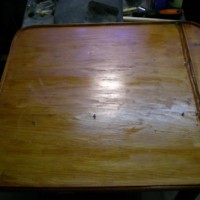
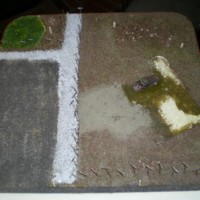
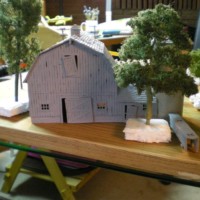
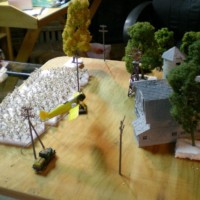
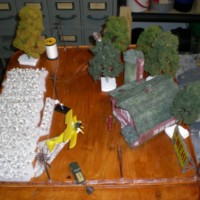
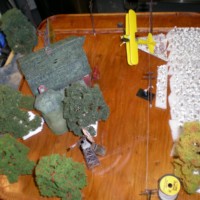
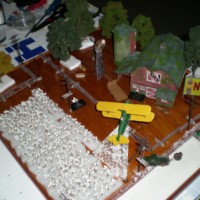
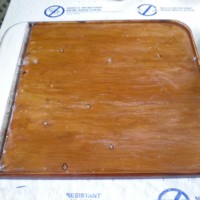
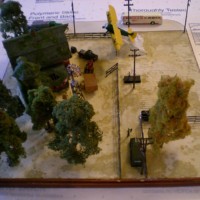
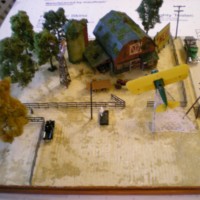
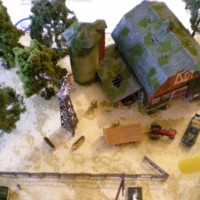
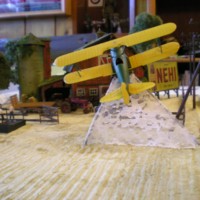
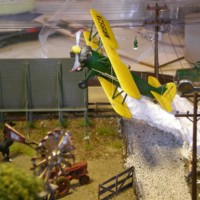
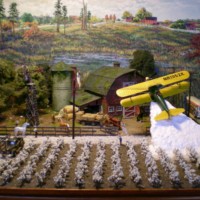
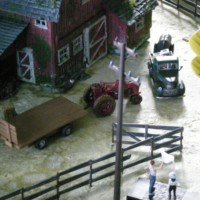
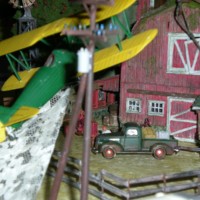
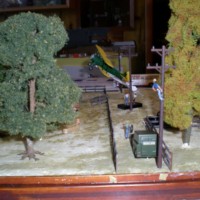
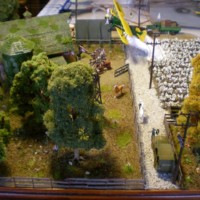


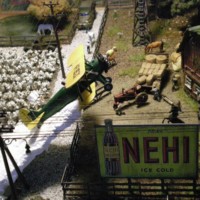
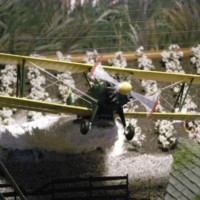
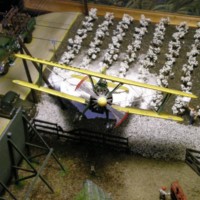
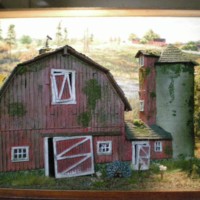
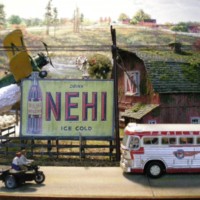
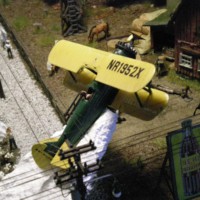
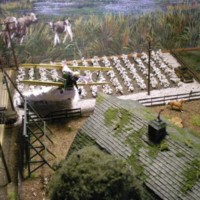
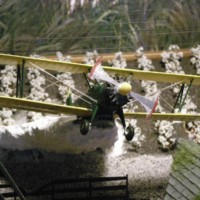

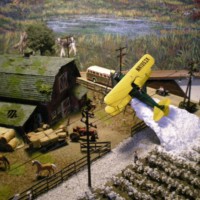
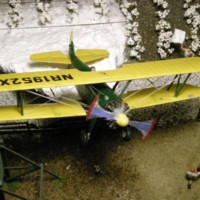
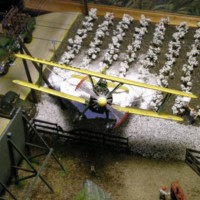
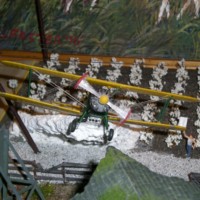
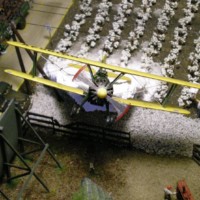
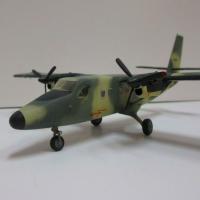
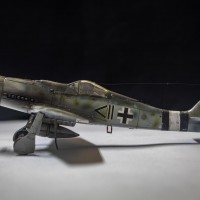
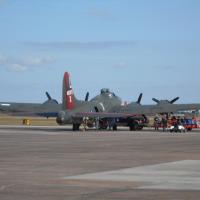
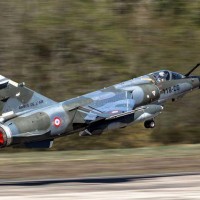
Wonderfully poetic
Love the diorama and period detail captures the time and place - great work.
What are you planning to do next?
Quite the imaginative piece of expert modeling there, sir. Very nicely presented. Welcome to iModeler...a place you'll learn to love, I'm sure. 🙂
I am doing a series of scenes from my flying career. Everything in the Farm diorama has a link to my life in agriculture. The next one, almost finished, is "The Hook Up" a 1/32 scale scene from a commercial sailplane operation I used to manage. It features a Super Cub tow plane hooking up to a Duo Discus sailplane.
The big one in the planning stages is "Caribbean Cargo," a 1/48 scale diorama from my time as a cargo pilot in St. Thomas. It features a large hanger, an operating beacon and water tower light with terminal building and control tower with working lights.
Aircraft will be a C-45 undergoing maintenance at the front of the hanger hanger with two Cubs in the back, J-3 and Super, along with various vehicles and figures. The hanger roof will be removable. A C-47 is on the ramp being loaded and fueled by a Tamyia fuel truck using a hydraulic ramp requisitioned from a Snark kit. The goon will be accompanied by an Antilles Airboats Grumman Goose at water's edge and maybe a PBY (the price for the latest version of that one is outrageous) I have all the components, all that remains is to assemble the pieces.
I flew a corporate Jets for while, but I just can't bring myself to use that as a diorama theme as jets have no smell in the cockpit and no soul, just pure mechanical efficiency.
Since this this will be my Sistine Chapel. I will probably do a 1/32 scale diorama of a V-1 Reichenberg on a Anhänger pulled by a Kettenkrad during the ensuing Caribbean project. And no, that scene is not part of my career.
This is my return to modeling after a twelve year hiatus from a life of sailing.
Superb work that you can recreate that history in a diorama like this. I definitely look forward to your coming expositions. What you did here is superb.
Stunning work! And a wonderful presentation
The humans, the animals, the hay, the crop, all poisoned. One wonders how means years this scene takes off the lives of every living thing in the diorama. American know-nothing moron stupidity at its height in the 1950s - it's amazing any of us alive back then survived.
The above takes nothing from the real artistry and craft and talent to conceive and execute this diorama.
"how many years"
Yeah, worse I used to do this for a living, but to be honest, it was the best flying I ever did. No rules, no radios, no instruments, just stick and rudder day long doing things at altitudes that would have regular pilots arrested the moment they touched down. There is nothing quite like the first swath run of the day in a 600 'cat or Air Tractor - 'cept maybe the last swath run of the day.
DDT's main drawback was its longevity. It remains active in the environment for decades. Yet it was actually far less toxic then the brews they put out today. In fact they used to dust people with it for lice control.
Modern chemicals decompose very quickly, usually within thirty days. While one could be dusted with DDT without ill effects, a single drop of an insecticide like Pydrin on the tongue is typically fatal. More than one pilot has crashed unscathed only to die from being bathed in poison. I used to carry an atropine kit with me in case of a crash. I had a few forced landings, but never damaged an airplane.
It hardly seems real now, like it's someone else's memories.
Yeah, worse I used to do this for a living, but to be honest, it was the best flying I ever did. No rules, no radios, no instruments, just stick and rudder day long doing things at altitudes that would have regular pilots arrested the moment they touched down. I started out flying a Stearman like the one in the diorama. There is nothing quite like the first swath run of the day in a 600 'cat or Air Tractor - 'cept maybe the last swath run of the day.
DDT's main drawback was its longevity. It remains active in the environment for decades. Yet it was actually far less toxic then the brews they put out today. In fact they used to dust people with it for lice control.
Modern chemicals decompose very quickly, usually within thirty days. While one could be dusted with DDT without ill effects, a single drop of an insecticide like Pydrin on the tongue is typically fatal. More than one pilot has crashed unscathed only to die from being bathed in poison. I used to carry an atropine kit with me in case of a crash. I had a few forced landings, but never damaged an airplane.
It hardly seems real now, I have to look at my logbook to make sure. It's like someone else's memories.
Sorry for the second post, I thought I was editing.
G.Ley, I really enjoy your entire scene here, a wonderful piece of history I remember well, having grown up in farm country. I always got extra excited when these flying farm hands would do their stuff. I particularly remember a class mates brother who crop dusted with a helicopter, watching him fly toward the road by our grade school, fly under the first wires and over the second wires on the other side of the street, spin around and go back. One of the best air shows I ever saw.
Thanks for the posting !
Wow! so much going on in this diorama! What's the scale?
The scale is HO or 1/87. Everything but the aircraft is that scale. The Stearman is slightly larger in 1/72. I couldn't find a 1/87 Stearman, so I went with the Revell model, reasoning that since the aircraft was the focal point it, it would be better in a bit larger scale anyway.
Later, I did obtain a Williams Brothers 1/87 Stearman, but after after looking at it, I found it was really too small in scale and did not allow for the P&W 985 engine upgrade. While Revell's puny Continental 220
made certain the pilot wasn't going to make it over the barn, Roll Model's beefy "Wasp" made certain it would.
The difference in the real aircraft is profound, I cannot imagine using a 220 Stearman for application, except perhaps for low volume work where only a few gallons of carrier is used. Using eight pound-per- gallon water as a carrier, one would have to make far too many trips back to operations to reload. And it is especially true in Ag-flying that "time is money".
There was even a "Bull Stearman" that mounted a 600 hp, P&W 1340. That bird was a real tail twister and had to be carefully managed on takeoff, lest the torque put one in the bar ditch. "Lefty" Gardener used a number of these aircraft at his Mercedes operation.
Great diorama, story, and back story!
Very nice - lots going on in that diorama, on many levels!
Great job
Beautifully built and the "true" story is VERY educating. Tom is right in his saying "it’s amazing any of us alive back then survived." So true.
Great scene! And your accounting of some of your flying career is VERY interesting to me.